Chilli cultivation is a good vegetable farming business. Chilli crops can be cultivated as an intercrop or standalone chilli plantation. Belonging to the family Solanaceae, Chilli or Mirchi is botanically called Capsicum annuum. It is a small, annual shrub with an erect, branched shoot. It has a tap root system with simple leaves. Unsurprisingly, the plants are most commonly grown to harvest their fruits, which are used as spices. In addition, the plants produce flowers with five teeth (petals), usually white.
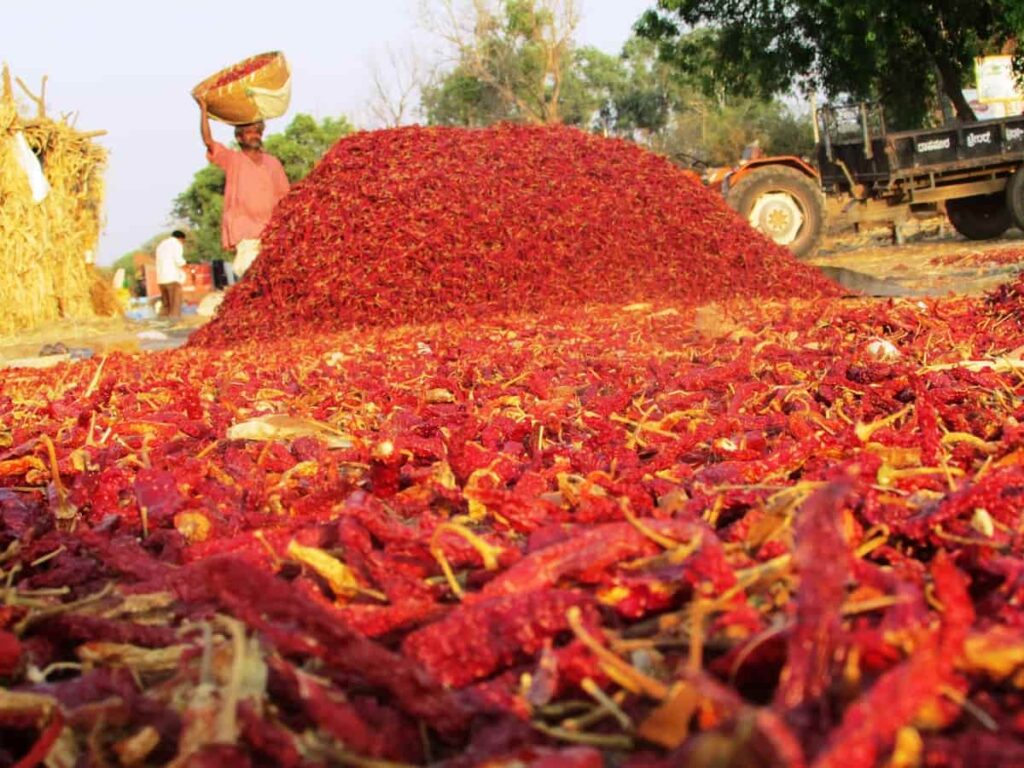
Chilli pepper plants can reach heights of 0.5 to 1.5 m tall, and although they are perennial species, they are commonly grown as annuals, with fruit being harvested for one growing season. Therefore, Chilli peppers may also be referred to as hot peppers or hot chillis. Below are the commonly seen pests and diseases in chilli farming. If you plan to cultivate chillies, this article will explain various pests and diseases and their control methods to get better yields.
How to control pests and diseases in Chilli Crop
Major pests in Chilli farming
Tobacco caterpillar
It is found throughout the tropical and sub-tropical parts of the world and is widespread in India. Besides tobacco, it feeds on cotton, groundnut, Chilli, cabbage, and other cruciferous crops. This polyphagous pest mainly damages the fruits by boring into them, and it can be seen in the post-rainy season. i.e., from November onwards
A Female lays about 300 eggs in clusters. Brown hairs and hatch cover the eggs in about 3-5 days. Caterpillar measures 35-40 mm in length when fully grown, and the larva stage lasts 15-30 days. The pupal stage lasts 7-15 days. The moth is medium-sized and stout-bodied with forewings of pale grey to dark brown
Damage symptoms
- The larvae of the second and third instar enter chilli pods by making a hole near the calyx and feeding on chilli seeds.
- Pods affected by this disease drop off or turn white when dried.
Biological control
- Grow castor along the border and irrigation channel as a trap crop
- Flood the field to drive out the hibernating larvae
- Set up a light trap at 1/ha or hand-pick grown-up larvae and kill them
- Spray Sl NPV at 1.5X1012 POBs/ha + 2.5 Kg crude sugar + 0.1 % teepol
Chemical control
- For every liter of liquid, spray 2.5 ml of Chlorpyriphos, 2 ml of Quinolphos, 2 ml of Endosulphan, 3 ml of Carbaryl, 2 ml of Monocrotophos, or 1 gm of Thiodicarb.
- Using 5kg of bran, 500gms of jaggery, and 500gms of Carbaryl, or 500ml of Monocrotophos, or chlorpyriphos, mixed with water, small pellets should be made in the field and applied in the evenings as bait.
Root-knot nematodes
Unlike most other parasitic nematodes, plant parasitic nematodes have a relatively simple life cycle that consists of an egg, four larval stages, and a male and a female adult. They are microscopic. In the egg, the first larval molt occurs during the first stage of development.
In the second stage, larvae hatch from eggs and invade plants’ roots or foliar tissues. In 4 to 8 weeks, depending on the temperature, new larvae emerge from the eggs and complete the life cycle. Nematode development is generally most rapid when the soil temperature is between 21 and 27°C.
In case you missed it: Growing Peppers from Seed to Harvest: For Bell Peppers, Chilli Peppers, Spicy/Hot Peppers, Sweet Peppers, and Jalapeno Peppers
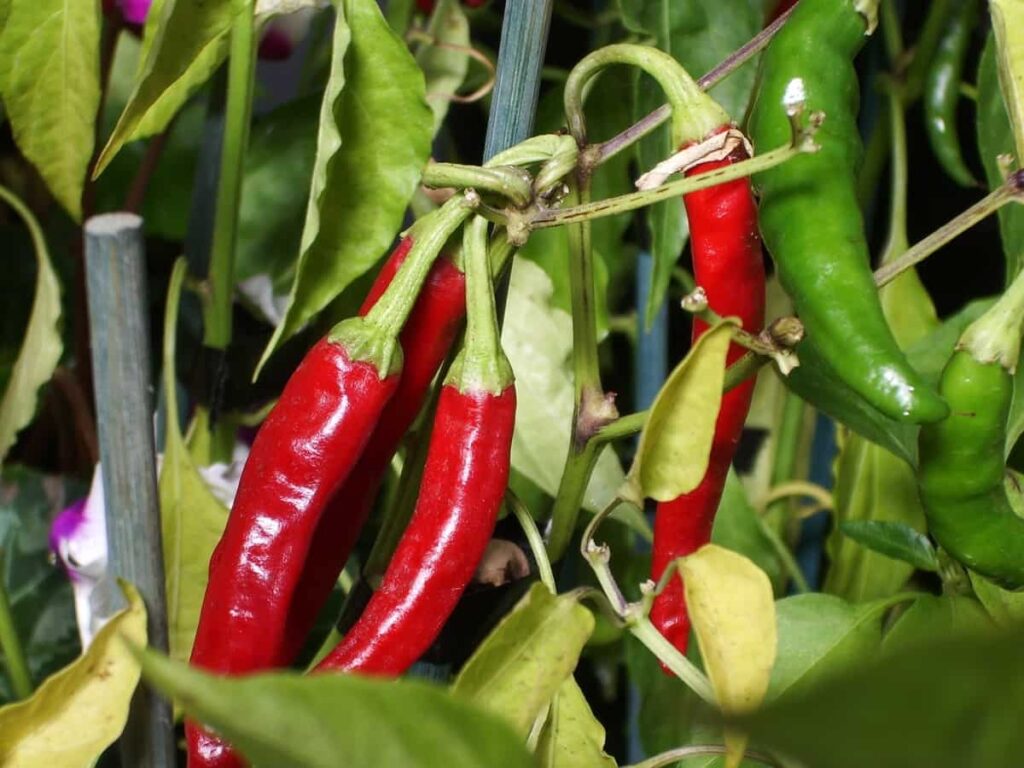
Damage symptoms
- Infected plants in patches in the field
- The primary symptom is the formation of galls on the host root system
- From the gall tissue, roots branch profusely, causing a ‘beard root’ symptom
- Knotty, knobby roots are caused by infection
- In severely infected plants, water and nutrients are insufficiently absorbed and transported by the roots
- Seedlings infected in the nursery do generally not survive transplanting, and those staying have reduced flowering and fruit production
Chemical control
- Following transplantation nearer to the root zone, carbofuran 3G granules of 50kg per acre should be applied.
- Apply 15 cartloads of farm yard manure along with 250 kg of Neem cake per acre and incorporate it into the soil before transplanting.
- Application of carbofuran 3G at 1kg a.i./ha.
Biological control
- Arthrobotrys dactyloides and A brochopaga form a ring trap around nematodes passing through them. Other fungi produce sticky nets, sticky knobs, and sticky spores.
- Other influential nematode fungal parasites are Pochonia chlamydosporia, Paecilomyces lilacinus, and Dactylella oviparasitica. There may be particular significance to these fungi when it comes to nematodes that aggregate their eggs and fungal food source in groups.
Thrips
Chilli thrips, Scirtothrips dorsalis, is native to south Asia and has become a worldwide pest in countries having horticulture commodities. It attacks over 100 plant species, including chili peppers, tea, strawberries, tomatoes, and many other vegetables, fruit, and ornamental crops. Chilli thrips feed on stem terminals, young leaves, and developing flower buds and fruits with a rasping-sucking mouthpart. Severe infestation can defoliate or slow plant growth.
Damage symptoms
- The infected leaves curl upward, crumble and shed
- Infested buds become brittle and dropdown.
- Affected fruits show light brown scars
- Early-stage infestation leads to stunted growth and flower production, and fruit sets are arrested
Biological control
- Biological control of thrips involves combining a range of beneficial insects and predators to protect plants from damage and stop populations from developing. The first and simple step is to place out yellow or blue sticky traps to monitor and catch adult thrips. It gives an early warning of activity and can help reduce egg-laying.
- Two predator-based products can help with this; Mighty Mite, which contains a soil-dwelling predatory mite that feeds on any small pupae or larvae it finds in growing media.
- If thrip adults are present on plants, the predatory bug; Orius should be introduced,
Chemical control
- Apply Carbofuran 3CG at 33 kg per hectare for better control of thrips in Chillies
- Use a pesticide that contains any one of the following chemical compounds.
| Chemical compound | Dosage (Per liter of water) |
| Imidacloprid 17.8 % SL | 3 ml |
| Dimethoate 30 % EC | 1ml |
| Emamectin benzoate 5 % SG | 4 grams |
| Ethion 50 % EC | 2 ml |
| Fipronil 5 % SC | 1.5 ml |
| Methyl demeton 25 % EC | 1 ml |
| Spinetoram 11.7 SC | 1.0ml |
| Spinosad 45 % SC | 3.2 ml |
| Phosalone 35 % EC | 2 ml |
| Oxydemeton –Methyl 25 % EC | 1 ml |
In case you missed it: Green Chilli Growing Tips, Ideas, and Techniques
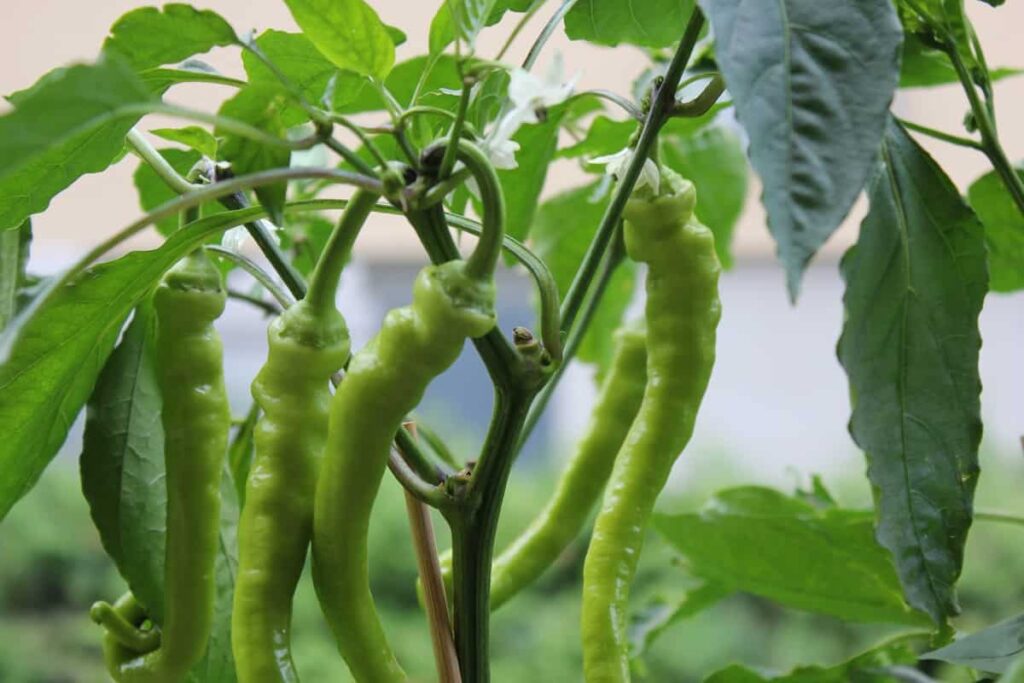
Spider mites/Yellow mites
The mite’s life cycle goes through four stages: egg, larva, nymph, and adult. The eggs are minute, oval, and laid on the ventral surface of young leaves or leaf buds. After hatching, the minute pear-shaped white larva having three pairs of legs moves sluggishly. Finally, the larvae’s transformation into an adult occurs during the nymphal stage. They are yellowish-green in color. There is no overwintering in the mites.
Damage symptoms:
- ‘Murda’ Disease of chillies is caused by nymphs and adults sucking sap from the plants and devitalizing them.
- Infestation results in the downward curling of leaves,
- The affected leaves become inverted boat-shaped,
- The leaves roll down along the margin with the elongation of petioles.
- Affected leaves turn dark green in some instances.
Biological control
- Predatory mites such as Phytoseiulus-System and Californicus-System
- Predatory gall midges such as Feltiella-System
- Nymphs of predatory bugs such as Macrolophus-N-System
Chemical control
- Encourage the activity of predatory mites: Amblyseius ovalis
- Apply phorate 10 % G @10 kg/ha or spray any one of the following insecticides
| Insecticide | Dosage |
| Chlorfenapyr 10 % SC | 1.5 ml/lit. |
| Ethion 50 % EC | 2.0 ml/lit. |
| Fenpyroximate 5 % EC | 1.0 ml/lit. |
| Oxydemeton –Methyl 25 % EC | 2.0 ml/lit. |
| Propargite 57 % EC | 2.5 ml/lit. |
| Quinalphos 25 % EC | 1.5 ml/lit. |
Aphids
A tiny, shiny black egg is found inside the plant’s buds, stems, and bark crevices. In warm climates, aphids do not lay eggs. Aphid nymphs (immature stages) are young aphids. Their appearance is similar to that of wingless adults, but they are smaller. Within 7 to 10 days, they become adults.
Soft-bodied adults with long antennae shaped like horns are small, 1 to 4 mm long and 1 to 4 mm long. In most cases, aphids have two short cornicles (horns) at the rear of their bodies. Additionally, aphids, directly and indirectly, reduce yields by transmitting virus diseases that act as vectors.
Damage symptoms
- It affects tender shoots, leaves, and the lower surfaces of leaves
- As honeydew is very sweet, sooty mold grows on the leaves, causing them to turn black.
- Suck the sap and reduce the vigor of the plant.
- Secret sweet substances attract ants and develop sooty mold.
- The pods that develop black color due to sooty mold lose quality and fetch a low price.
Biological control
- Predators and parasitoids are the most common bioagents used to control other insects. Predators such as ladybird beetles or dragonflies devour prey insects and usually consume much prey in their lifetimes.
Chemical control
- A solution consisting of 0.1% Dimethoate in one-liter water, Methyl Demeton in one-liter water, Monocrotophos in 1.5 ml, or Acephate in 1g in one-liter water should be sprayed.
- Aphid populations should be checked every ten days with alternate chemicals. It is easy for aphids to migrate from one field to another in their winged forms. Therefore, spraying should be completed within a day or two as far as possible.
Whitefly
Females lay stalked yellow spindle-shaped eggs singly on the lower surface of leaves throughout the year. The eggs will hatch in a week. As the Nymphal stage develops, it remains attached to the lower side of leaves for about four weeks. The number of generations varies between 12-15 per year. Nymphs are Oval, Scale, and remain attached to the leaf surface. Adults are tiny, moth-like, with yellowish bodies and wings coated with milky white waxy powder.
In case you missed it: How To Grow Chilli Plants At Home (Pepper/Mirchi)

Damage symptoms
- In addition to sucking sap from leaves, nymphs and adults produce honeydew, which causes lint contamination.
- The leaves look sickly and are coated with sooty mold. It also transmits the leaf curl virus.
Biological control
- Whiteflies can be attracted and controlled by yellow sticky traps coated with grease and sticky oils.
- The predatory mite Amblyseius swirskii is another important biological control agent to complement parasitoids in poinsettia production. These tiny predators eat whitefly eggs and small nymphs but also are fantastic predators of thrips.
- Delphastus catalinae are tiny black lady beetles. They are less than 2 mm long, but the adults and larvae feed voraciously on whitefly eggs and nymphs
- Finally, pathogens like Beauveria bassiana are good biological control options for whitefly management.
Chemical control
- Spray Triazophos 2 ml/liter of water or Prophanophos 2 ml/liter of water.
- The use of Synthetic Pyrethroids increases the intensity of whiteflies.
- Spraying of any Neem product, 5% Neem oil before egg laying, or 5 kg Neem Kernel extract per acre with any sticky material.
Chilli diseases
Damping off
This soil-borne fungal disease primarily affects seeds and new seedlings of vegetable crops. Damping-off refers to the decay of stem and root tissues below the soil line. When old seeds are planted in cold, wet soil temperatures, damping-off is more likely to occur, and poor drainage further exacerbates the problem.
Growing conditions such as high humidity levels, cool soil, rich potting soil, and planting too deeply will also encourage its growth. The disease of nursery beds and young seedlings results in reduced seed germination and poor stand of seedlings. Very high seedling mortality 25-75%
- Pre-emergence damping off: Seedlings disintegrate before they come out of the soil surface, leading to poor seed germination
- Post-emergence damping off: The development of disease is characterized after seedlings emerge out of the soil but before the stems are lignified
Damage symptom
- Water-soaked lesion formation at the collar region
- Infected areas turn brown and rot
- As a result of softening tissues, plants wilt and collapse
- Rhizoctonia solani attacks produce hard, thin wire stem symptoms, and seedlings topple over. The disease appears in patches both in nursery and field beds.
In case you missed it: Pepper Varieties to Grow at Home (Chilli) – a Full Guide
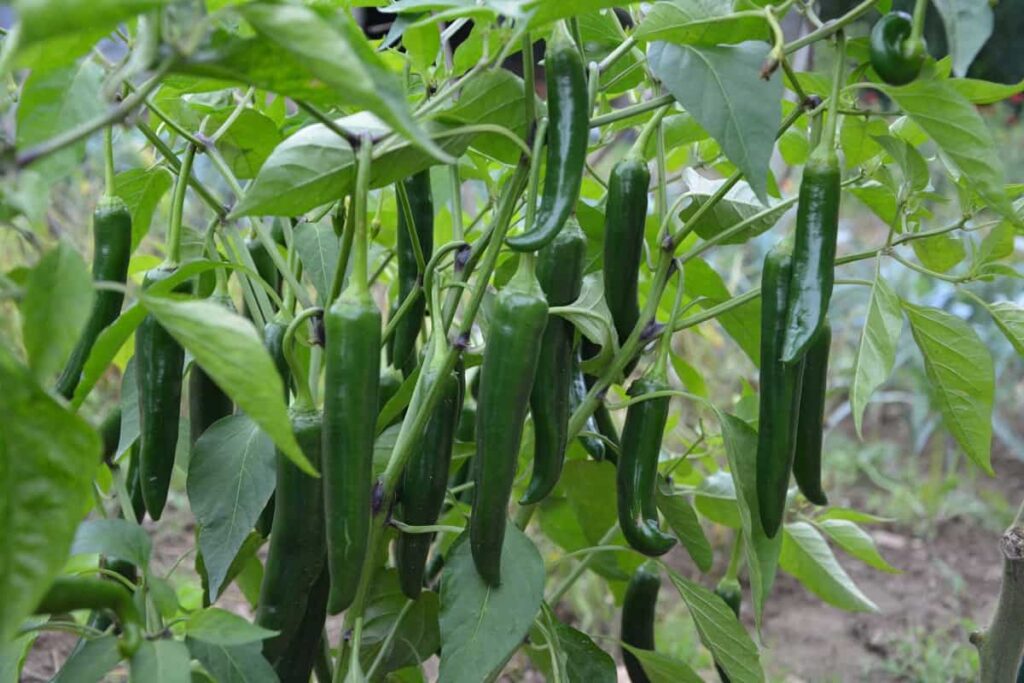
Chemical control and management
- Avoid shade places for nursery establishment
- Use recommended seed rate
- Avoid flooding type of irrigation and maintain the optimum moisture level in the nursery
- Seeds should be treated with Trichoderma asperellum at 4 g / kg of seeds or Pseudomonas fluorescens at 10 g / kg of seeds 24 hours before sowing
- Using 50 kg of farm yard manure, apply 2.5 kg of P. fluorescens per hectare.
- Soil drenching with Copper oxychloride 0.25%
- Use Thiram or Captan at 4g/ kg of seeds for seed rate
Powdery mildew
Chilli crop is susceptible to various diseases; powdery mildew is one of the severe threats to chilli production. The main cause of this disease is Leveilulla Taurica fungus. As a result, extreme defoliation becomes one of the significant restricting factors in fruit growth. In addition, the infection reduces the photosynthetic activity and transforms the plant’s physiological structure, gradually leading to a decline in yield.
Damage symptoms
- The white powdery coating appears mainly on the lower surface and occasionally on the upper surface.
- Yellow patches can also be seen on the upper surface.
- Many infections result in the leaves being dried and shed.
- Branches and young fruits can also display powdery growth.
- Diseased fruits do not grow further and may drop down prematurely.
Chemical control and management
- Clean up fallen debris on the ground and remove diseased foliage from the plant.
- After raking and cleaning the soil well, cover it with a thick layer of mulch or organic compost. The mulch will prevent the disease spores from splashing back up onto the leaves.
- Spraying of fungicides
| Chemical compound | Dosage (Per liter of water) |
| Carbendazim | 1ml |
| Propiconazole | 1ml |
| Penconazole | 1 ml |
| Wettable sulfur | 2.5 grams |
| Hexaconazole | 1 ml |
| Difenconazole | 1 ml |
Bacterial leaf spot
The most common destructive disease for chillies is bacterial leaf spot, caused by Xanthomonas campestris pv vesicatoria. A rod-shaped, gram-negative bacterium can survive in seeds and plant debris from one season to another. Due to strict host specificity, different strains or races of the bacterium cause disease symptoms in certain varieties. Bacterial leaf spots can devastate a Chilli crop by defoliating infected leaves and disfiguring the fruit early in the season.
Damage symptoms
- Lesions on the leaf begin as circular, water-soaked spots
- Spots become necrotic with the brown center with chlorotic borders
- Enlarged spots may develop straw-colored centers
- Lesions are slightly raised on the lower leaf surface
- Severely spotted leaves turn yellow and drop
- Stems may develop narrow, elongated lesions or streaks
Chemical control and management
- Spray mancozeb at two grams per liter or copper oxychloride at 2.5 grams per liter.
- Treat seeds for 2 to 5 minutes effectively with mercuric chloride solution containing 0.1%.
- Copper oxychloride 0.25% in the Bordeaux mixture can be sprayed on seedlings.
- After fruits have formed, streptomycin should not be sprayed.
In case you missed it: Container Organic Chilli Gardening (Peppers)
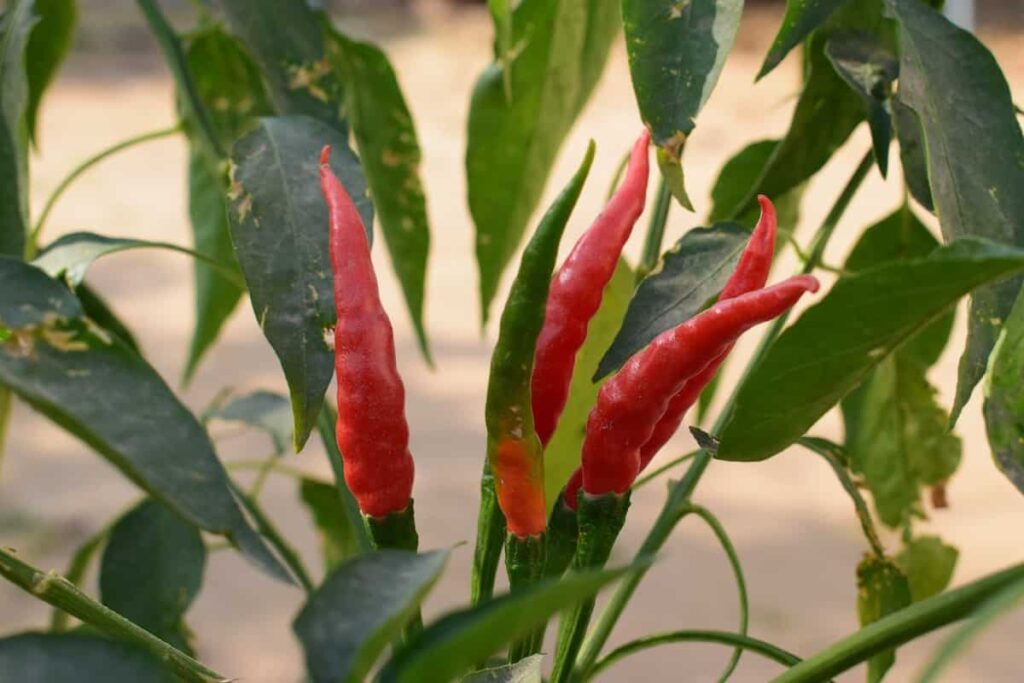
Die-back and Anthracnose (fruit rot)
The word anthracnose is derived from the Greek language meaning ‘coal’ it is the common name of a plant disease with very dark, sunken lesions and containing fungal spores. Besides fruit rot, it can also cause leaf spots, stem die-back, seedling blight, or damping off. In transplanted crops, the disease is more prevalent in December – October.
Symptoms
- Spots appear on leaves in a circular to irregular shapes that are brownish-black
- Defoliation occurs on severely infected leaves
- Necrosis of branches is caused by infection of the growing tips
- Flower shedding due to infection at the pedicel and branch tips
Chemical control and management
- This disease is widely recommended to be managed with protective fungicides such as manganese ethylene bisdithiocarbamate.
- Mancozeb (0.2%), Ziram (0.1%), copper oxychloride fungicide (Blitox 50), and Bordeaux mixture (0.5 or 1%) of a copper sulfate fungicide were also effective.
- It is recommended to treat seeds with benzimidazole fungicides and strobilurin fungicides. For better control of the disease, chilli seeds were soaked in 0.2% Thiram, a dithiocarbamate fungicide, for 12 hours.
Conclusion
Diseases in chilli plants are less common but often more dangerous to plants. Diseases are mainly affected due to Bacteria, Fungi, Viruses, and Other sources. The disease mainly affects yields by reducing the photosynthetic area in the early stages and infestation on reproductive parts and the yields at later stages. Pests also significantly reduce the yield along with diseases.
- Flower Garden Designs and Layouts for Beginners
- Planting and Spacing Techniques in Papaya: A Beginner’s Guide
- Growing Gold: Essential Techniques for Planting Pineapples
- How to Make Kalanchoe Plant Bushy: Home Remedies and Solutions
- 11 Reasons Why Your Gardenia is Not Blooming: Home Remedies and Solutions
- Eco Elegance: The Guide to Designing a Drought-Tolerant Landscape
- Gardening on a Slope: Strategies for Hillside Landscaping
- Nourish and Flourish: Top Organic Mulches for Thriving House Plants
- Everything You Want to Know about Indian Mogra Flower: Discover Uses and Growing
- Green Thumb Success: Expert Tips for Cultivating Greenhouse Pumpkins All Year Round
- Maximize Growth & Flavor: The Ultimate Guide to Companion Planting in Herb Gardens
- How to Control Rhododendron Problems Naturally: Home Remedies and Organic Ways to Fix Them
- Natural Magic: The Remarkable Benefits of Cinnamon for Plants
- Best Steps to Revive Dying Tulip with Natural and Organic Treatment
- 10 Reasons Why Your Angel Trumpet is Not Blooming: Remedies and Treatment
- How to Fix Periwinkle Leaf and Flower-Related Problems: Natural Remedies and Solutions
- How to Fix Zinnias Leaf and Flower Problems: Discover Natural and Home Remedies
- Organic Steps to Induce Lemon Tree Flowers: A Comprehensive Guide
- Bloom Booster: Crafting the Perfect Homemade Bougainvillea Fertilizer
- Optimizing Growth: A Guide to Applying NPK Fertilizer for Potted Plants
- 10 Best Homemade Fertilizers for Rubber Plant: DIY Recipes and Application Method
- How to Boost Female Pumpkin Flowers: Effective Steps for More Flowers and High Yields
- Transform Your Indoor Garden: Top Benefits of Pink Salt for Houseplants
- 10 Best Homemade Fertilizers for Peacock Plants (Calathea): Easy DIY Guide
- Unlock Blooms: 9 Reasons Why Your Potted Chrysanthemum is Not Blooming
- 8 Reasons Why Your Potted Hibiscus is Not Blooming: Fix it with Simple Solutions
- Unlock Blooms: 9 Key Reasons Your Potted Frangipani Won’t Flower
- 10 Reasons Why Is My Ice Plant Not Blooming: Remedies and Treatment
- 10 Reasons Why My Potted Hydrangea Not Blooming: Treatment and Remedies
- 10 Reasons Why is My Wisteria Not Blooming: Remedies and Treatment
- 10 Reasons Why is My Goldfish Plant Not Blooming: Remedies and Treatment
- Maximize Your Space: Ultimate Guide to Balcony Gardening with Grow Bags
- 10 Reasons Why Your Iris is Not Blooming: Remedies and Treatment
- 10 Reasons Why Your Anthurium Plant is Not Blooming: Treatment and Remedies
- 10 Reasons Why Your Aquaponic Plants Are Not Flowering: Remedies and Treatment
- 10 Reasons Why Your Agapanthus is Not Flowering: Remedies and Treatment